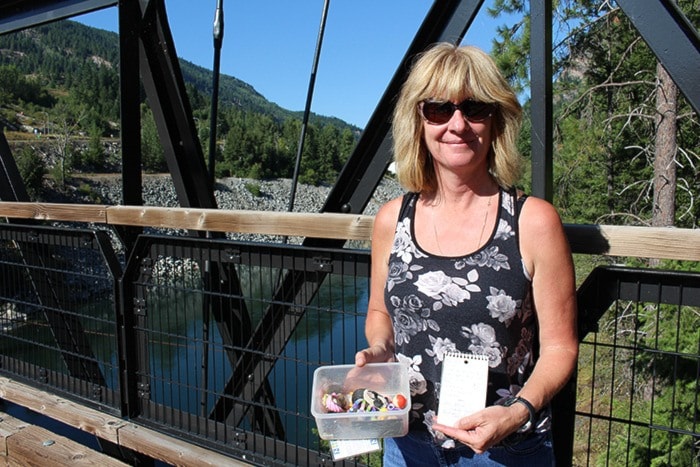Carol Breakwell and her husband Ed have been geocaching since 2002, when Ed heard about a fun game played with handheld GPS units.
At the time, the closest geocache was at Pilot Bay, so they jumped on a ferry and went to look. They didn't find it the first time, but they went back, and found their first cache.
“I was instantly hooked the minute we opened it up,” said Carol. “There were little trade items. I brought a stuffed toy home, and that was it, I couldn't wait to do the next one.”
Geocaching
Geocaching has been around since 2000, when the U.S. government disabled selective availability for GPS satellites, thereby drastically improving the GPS technology available to the public.
A GPS enthusiast by the name of Dave Ulmer came up with the idea to hide a container and post the coordinates of its location online, so that others could go find it. And they did.
The phenomenon quickly swept the internet and eventually geocaching.com was born.
Now there's no need to even buy a GPS unit. Geocachers or cachers can simply download the geocaching app on their smartphones, and jump to it.
The app shows any caches in the area, and helps users navigate to any given cache's location. Then its time to get searching.
Most caches are well hidden; simply finding the coordinates doesn't guarantee finding the cache. Some will even stare geocachers right in the face, without them knowing it.

Creative caches
Breakwell and her husband have now found over 48,000 caches, and have hidden a number of their own. They cache under the name kootenay pirates, and plan vacations around Geocaching. They've cached as far as Hawaii, Alaska, and Mexico.
While many of the caches they've found have been hidden in simple containers that were painted or decorated to blend in with their surroundings, or hidden under things, others were creative caches.
One example was the Big Enormous Cache in Calgary, AB.
“It was a pup tent in a park, and everyone thought it was a homeless person's tent and left it alone,” said Breakwell. “But as soon as you unzipped it, the pencil was one of those big foot-long pencils ... and all the trade items were huge.”
A Castlegar example of a creative cache is Industrial Tube on Minto Rd. We won't give away the secret, but getting the cache out of the tube is pretty tricky.
Terrain
But sometimes the trick is getting to the cache in the first place. Each geocache description includes a cache's terrain rating, which lets the cacher know how hard it is to reach the location.
Caches with a terrain rating of one can be accessed by anyone, while caches with a terrain rating of five often require special equipment or skills to reach them.
Breakwell and her husband have done 150 terrain five caches.
“We like some of the harder hikes,” says Breakwell, “and we did have a boat at one time, so we did a lot of boat caches that are considered terrain five because you need a boat to get to them.”
They haven't done any extreme rock climbing caches, but as far as Breakwell knows, there aren't any in the area.

Trackables
Once a cacher has found a cache they can sign the logbook and mark it as found in the app.
Some caches have tradable items like the stuffed animal Breakwell found in her first cache. Some also have trackables.
A trackable is purchased off the geocaching website, placed in a cache, and picked up by someone else to be moved to a different cache, where someone else can find it.
Cachers can track the item's progress as it circles the globe by entering an engraved code on the website.
“I've seen teachers use them for their classes,” says Breakwell. “It's a great way to get them to study [geography.]”
Travelbugs and Geocoins are among some of the most common trackables. They both work essentially the same way, but Geocoins are a little different.
They are created by individuals or groups as a signature item or calling card, and are sometimes given away as a promotional items.
For instance, they are often used as incentives to get people to complete GeoTours.
GeoTours
GeoTours are multiple caches setup with the specific purpose of drawing geocache tourists to an area.
Breakwell and her husband recently traveled to Pend Oreille, Wash. where a GeoTour with 25 caches was setup. Cachers who find all 25 receive a commemorative Geocoin.
“Geotourism is really catching on, because they're realizing that people will travel to come and find geocaches,” said Breakwell.
In B.C., Backroad Mapbooks has setup a GeoTour for each region of the province, including the Kootenay Rockies. Finding all three caches in each region earns you a Geocoin with the region's emblem, and finding all the caches in all the regions, plus two bonus caches, can earn you an additional GeoCoin.
Unfortunately none of the Backroad Mapbook caches are in Castlegar, and Breakwell says she'd like to see a GeoTour in the area.
“I'd like to see some kind of Geotourism from Castlegar or the Kootenays—Castlegar, Nelson, Trail—and draw those people into our areas, and do a coin challenge,” said Breakwell.
